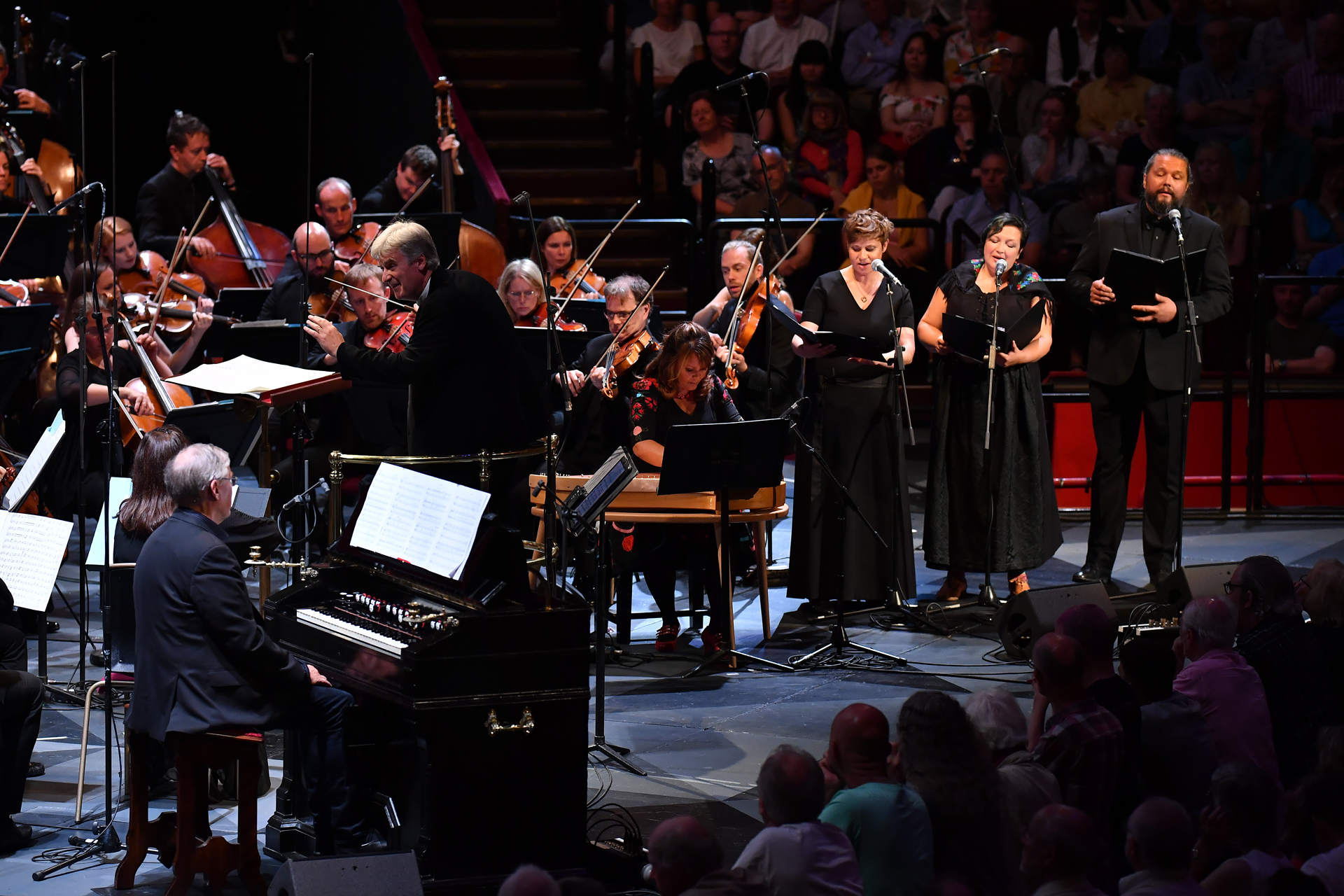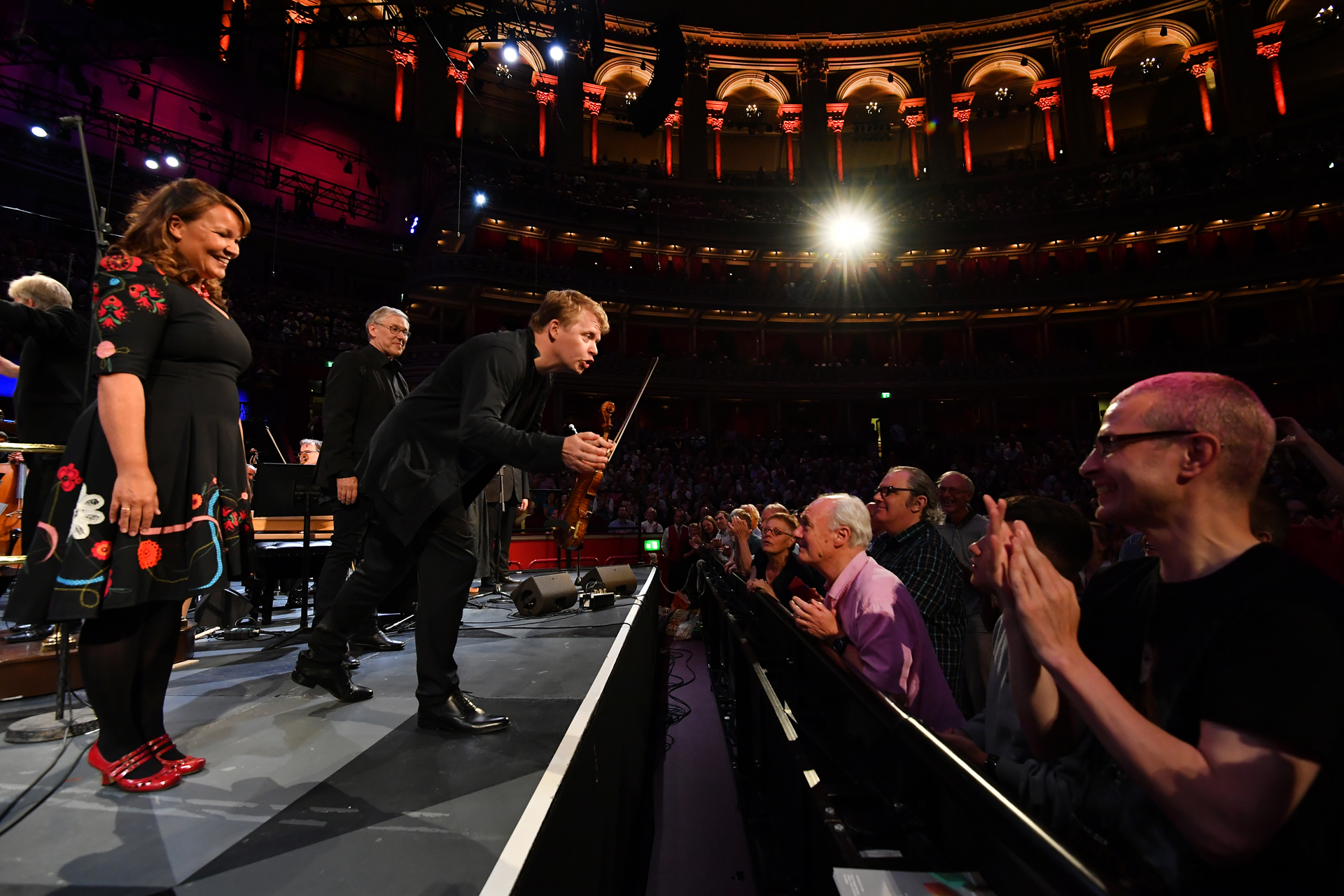Prom 20: Kuusisto, BBCSSO, Dausgaard review – Sibelius between folk and art | reviews, news & interviews
Prom 20: Kuusisto, BBCSSO, Dausgaard review – Sibelius between folk and art
Prom 20: Kuusisto, BBCSSO, Dausgaard review – Sibelius between folk and art
Tastes of the composer's Finnish roots – and the first edition of a masterpiece
I’m not quite sure that I should review this Prom, since I performed in it. Before anyone summons the white coats, let me clarify. As the encore to a mind-expanding evening, Finnish violinist Pekka Kuusisto returned to the stage with his band of folk musicians. He asked the audience to hum a sort of drone, and then sing open-mouthed, as they sung and played a traditional song. How did we do? OK, I thought.
How often do we read about the alleged folk roots of the great “national” composers of the late 19th and early 20th centuries? But how infrequently do musicians and their patrons take any steps to help us hear those legacies, rather than simply trust a programme note. On Saturday, Thomas Dausgaard and the BBC Scottish Symphony Orchestra prefaced two familiar works from today’s standard repertoire – Sibelius’s Violin Concerto and his Fifth Symphony (but performed last night in its lesser-known, original version) – with mini-concerts of Finnish folk music. These preludes invited us to spot the folk themes’ affinities with motifs from the two masterworks – but also to decide for ourselves what, precisely, the master himself did with these echoes. 
More so than with many of his peers, this was a provocative frame in which to place Sibelius – who insisted that his unique, hard-won soundscapes never depended on borrowed musical folklore. Yet for all its anti-programmatic self-sufficiency, every listener to Sibelius somehow hears in his music the landscapes and accents of his native land. The preludes allowed us to appreciate – if not resolve – this paradox. Yes, the melodies from old Finnish song collections, chanted and played by our ad hoc country band and their rune singers, evidently rhymed with figures and motifs that we hear in the two major works. Equally, the changes Sibelius wrought on these faint, perhaps dimly remembered, folk elements feel utterly transformative. I had some doubts, too, about the presentation of the traditional material. The BBCSSO partnered the Finns, playing relevant snatches of the finished works to come (which followed the preludes without a break) as a sort of background muzak. This felt like a needless distraction. With these fine performers on stage, I would have preferred an undiluted shot of Finnish traditional styles, rather than a cocktail that mixed the sounds outside Sibelius’s window with the personal magic he summoned within.

The balance seemed awry at times during the opening allegro, although Kuusisto’s freewheeling approach played splendid dividends in the explosive cadenza. As the fiddler skipped and dodged through the movement’s tumbling profusion of ideas, the BBCSSO – its dark brass an especially formidable presence at the back – anchored his journey with robust and earthy flavours of its own. The long, reflective adagio supplied a beautiful showcase for Kuusisto’s more tender, introspective side. In the stomping dance of the finale he sailed through the perilous high-speed passages of double-stops and crossed strings with dazzling aplomb and sheer cheek. Big-boned, tightly-controlled orchestral tutti enhanced the thrills. Then came a first-half encore, genial yet melancholic, of a Sibelius Humoresque: the idea of “longing” distilled, Kuusisto told us. Which goes for much of the mighty Finn’s output.

All of which Dausgaard and the BBCSSO conveyed with ferocious commitment and a varied palette of well-defined colours. I relished the edgy bite of the flutes in the (original) scherzo; the moody horns and frenetic plucked strings of the adagio; not to mention the positively shocking brass disruptions of those soaring swans, along with the pianissimo strings that ushered in the now-ambiguous tutti of the finale. Curiously, this impassioned account of a highly-wrought and broodingly intense work made Sibelius sound like more of an avant-garde explorer, and less of a homely “folk” composer, than the version we normally hear. He remains a great, fathomless paradox. With Dausgaard and Kuusisto as our guides, it was a treat to dive further into his depths. Meanwhile, the folk-ensemble prelude might suit plenty of other pioneers, from Brahms to Stravinsky, Britten to Bartok. Worth a Proms try?
rating
Explore topics
Share this article
The future of Arts Journalism
You can stop theartsdesk.com closing!
We urgently need financing to survive. Our fundraising drive has thus far raised £49,000 but we need to reach £100,000 or we will be forced to close. Please contribute here: https://gofund.me/c3f6033d
And if you can forward this information to anyone who might assist, we’d be grateful.

Subscribe to theartsdesk.com
Thank you for continuing to read our work on theartsdesk.com. For unlimited access to every article in its entirety, including our archive of more than 15,000 pieces, we're asking for £5 per month or £40 per year. We feel it's a very good deal, and hope you do too.
To take a subscription now simply click here.
And if you're looking for that extra gift for a friend or family member, why not treat them to a theartsdesk.com gift subscription?
more Classical music
 Bizet in 150th anniversary year: rich and rare French offerings from Palazzetto Bru Zane
Specialists in French romantic music unveil a treasure trove both live and on disc
Bizet in 150th anniversary year: rich and rare French offerings from Palazzetto Bru Zane
Specialists in French romantic music unveil a treasure trove both live and on disc
 Scottish Chamber Orchestra, Ibragimova, Queen’s Hall, Edinburgh review - rarities, novelties and drumrolls
A pity the SCO didn't pick a better showcase for a shining guest artist
Scottish Chamber Orchestra, Ibragimova, Queen’s Hall, Edinburgh review - rarities, novelties and drumrolls
A pity the SCO didn't pick a better showcase for a shining guest artist
 Kilsby, Parkes, Sinfonia of London, Wilson, Barbican review - string things zing and sing in expert hands
British masterpieces for strings plus other-worldly tenor and horn - and a muscular rarity
Kilsby, Parkes, Sinfonia of London, Wilson, Barbican review - string things zing and sing in expert hands
British masterpieces for strings plus other-worldly tenor and horn - and a muscular rarity
 From Historical to Hip-Hop, Classically Black Music Festival, Kings Place review - a cluster of impressive stars for the future
From quasi-Mozartian elegance to the gritty humour of a kitchen inspection
From Historical to Hip-Hop, Classically Black Music Festival, Kings Place review - a cluster of impressive stars for the future
From quasi-Mozartian elegance to the gritty humour of a kitchen inspection
 Shibe, LSO, Adès, Barbican review - gaudy and glorious new music alongside serene Sibelius
Adès’s passion makes persuasive case for the music he loves, both new and old
Shibe, LSO, Adès, Barbican review - gaudy and glorious new music alongside serene Sibelius
Adès’s passion makes persuasive case for the music he loves, both new and old
 Anja Mittermüller, Richard Fu, Wigmore Hall review - a glorious hall debut
The Austrian mezzo shines - at the age of 22
Anja Mittermüller, Richard Fu, Wigmore Hall review - a glorious hall debut
The Austrian mezzo shines - at the age of 22
 First Person: clarinettist Oliver Pashley on the new horizons of The Hermes Experiment's latest album
Compositions by members of this unusual quartet feature for the first time
First Person: clarinettist Oliver Pashley on the new horizons of The Hermes Experiment's latest album
Compositions by members of this unusual quartet feature for the first time
 Gesualdo Passione, Les Arts Florissants, Amala Dior Company, Barbican review - inspired collaboration excavates the music's humanity
At times it was like watching an anarchic religious procession
Gesualdo Passione, Les Arts Florissants, Amala Dior Company, Barbican review - inspired collaboration excavates the music's humanity
At times it was like watching an anarchic religious procession
 Classical CDs: Camels, concrete and cabaret
An influential American composer's 90th birthday box, plus British piano concertos and a father-and-son duo
Classical CDs: Camels, concrete and cabaret
An influential American composer's 90th birthday box, plus British piano concertos and a father-and-son duo
 Cockerham, Manchester Camerata, Sheen, Martin Harris Centre, Manchester review - re-enacting the dawn of modernism
Two UK premieres added to three miniatures from a seminal event of January 1914
Cockerham, Manchester Camerata, Sheen, Martin Harris Centre, Manchester review - re-enacting the dawn of modernism
Two UK premieres added to three miniatures from a seminal event of January 1914
 Kempf, Brno Philharmonic, Davies, Bridgewater Hall, Manchester review - European tradition meets American jazz
Bouncing Czechs enjoy their Gershwin and Brubeck alongside Janáček and Dvořák
Kempf, Brno Philharmonic, Davies, Bridgewater Hall, Manchester review - European tradition meets American jazz
Bouncing Czechs enjoy their Gershwin and Brubeck alongside Janáček and Dvořák
 Solomon, OAE, Butt, QEH review - daft Biblical whitewashing with great choruses
Even a top soprano and mezzo can’t make this Handel paean wholly convincing
Solomon, OAE, Butt, QEH review - daft Biblical whitewashing with great choruses
Even a top soprano and mezzo can’t make this Handel paean wholly convincing

Add comment